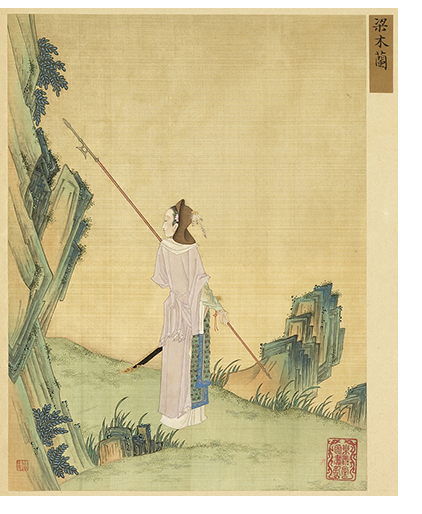Mulan
Mulan
The legend of Fa Mulan honors one of the most important values in ancient Chinese society - respect and sacrifice for one’s family. Disney’s Mulan, however, places a heavy focus on Mulan’s struggles as a woman trying to dress and act like a man. Third wave feminist ideas that became popular in 1990s America influenced the alterations in the story and the character of Mulan in Disney’s interpretation.

Disney’s Mulan was inspired by the ancient Chinese poem named “Ode of Mulan” (or “Ballad of Mulan,” depending on the translation). This poem was said to have been composed in the Northern Dynasties (c. 386–581) and collected in a written art anthology entitled Yuefu Shiji in the Song Dynasty (c. 960–1279), compiled by Maoqian Guo (Dong, pg 219). It told the tale of a young woman who dresses as a man in order to take her weak, old father’s place in the military draft. She becomes a celebrated warrior, then returns home to be reunited with her family. The story symbolizes the importance of making family one’s highest priority and sacrificing anything for a family member in need. This tale was surprisingly feminist for its time and location; even so, it continued to be a commonly known and well-liked tale within Chinese culture.
Maxine Hong Kingston, a Chinese-American author, published a memoir in 1976 entitled A Woman Warrior: Memoirs of a Girlhood Among Ghosts. In this book, her chapter “White Tigers” discusses a version of the legend of Mulan that Kingston’s mother had told her as a child. This version focused much more on gender barriers than the original poem; she contrasts Mulan’s strength and power to the sexist comments and expectations Kingston faced in American society, especially in Chinese-American culture. Her work has been criticized for being orientalist and untrue to the original tale (Lan, pg. 229). Kingston’s Americanized portrayal of Mulan as a strong female character resonated with second wave feminists during this time and brought the legend of Mulan into the awareness of a western audience.
Disney’s Mulan, released in 1998, incorporates this gender-focused aspect of Kingston’s Mulan tale, although its portrayal of the titular character is a bit different. Contrary to the original tale, Disney’s Mulan frequently discusses her struggles as she attempts to act masculine. She is shunned when her military commander discovers she is a woman, afterwards being mistrusted by men in administrative power and forced to take the matter of defeating the attacking Huns into her own hands. Disney’s take on Mulan is an example of the kind of female icon that became popular during the rise of third-wave feminism. A major ideology of third-wave feminism is that a woman should not need to act like a man to be respected or successful (Kimball, pg. 198-199). This idea is present in Disney’s Mulan, as she is ultimately respected and revered as a woman when she defeats the Huns. Disney portrays Mulan as not stereotypically feminine (exemplified in the matchmaker scene) yet still not a man. She is able to embrace her femininity in a unique way as she no longer needs to pretend to be a man in order to get her happy ending.
Disney’s Mulan loosely bases its plot on the original “Ode of Mulan” while incorporating 1990s American feminist ideas. It can be interpreted as symbolism for a criticism of first and second-wave feminism and the shift to third-wave feminist ideology. Mulan is most powerful not when she is pretending to be a man, but when she is true to her identity as a woman.
Discussion of "Mulan"
Add your voice to this discussion.
Checking your signed in status ...